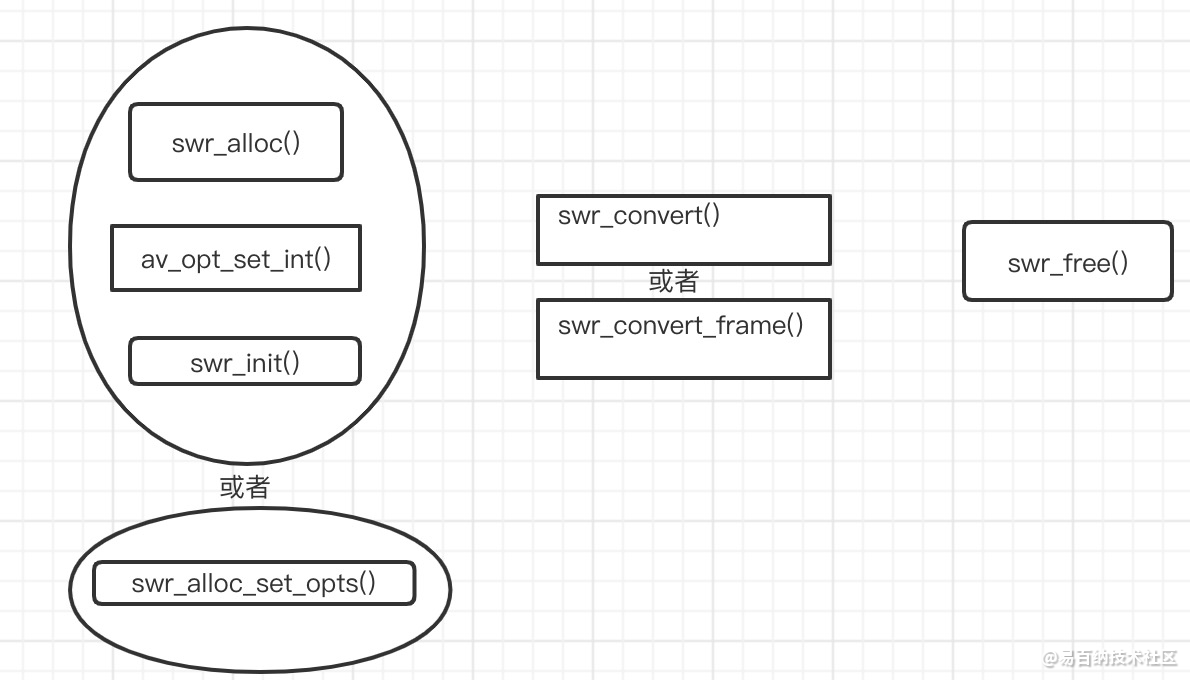技术专栏
ffmpeg(五)音频重采样
前言
广义的音频重采样包括:
1、采样格式转化:比如采样格式从16位整形变为浮点型
2、采样率的转换:降采样和升采样,比如44100采样率降为2000采样率
3、存放方式转化:音频数据从packet方式变为planner方式。有的硬件平台在播放声音时需要的音频数据是planner格式的,而有的可能又是packet格式的,或者其它需求原因经常需要进行这种存放方式的转化
通常意义上的音频重采样是指上述的第2点,即升采样和降采样,这个对音质有一定影响
重采样相关函数流程图

重采样ffmpeg相关函数介绍
这些重采样函数都位于头文件<libswresampe/swresample.h>
- 1、SwrContext
实现重采样的上下文,它是一个结构体,具体定义未知 - 2、SwrContext *swr_alloc();
分配上下对象 - 3、
int av_opt_set_int(void obj,char name,int64_t val,int search_flags);
int av_opt_set_sample_fmt(void obj,char name,enum AVSampleFormat fmt,int search_flags);
给上下文对象设置重采样的转换参数 - 4、int swr_init(struct SwrContext * swrCtx);
设置参数之后初始化重采样上下文 - 5、struct SwrContext swr_alloc_set_opts(struct SwrContext swr_ctx,
int64_t out_ch_layout,enum AVSampleFormat out_sample_fmt,int out_sample_rate,
int64_t in_ch_layout,enum AVSampleFormat in_ch_layout,int in_sample_rate
);
此函数功能相当于上面1、2、3、4所有函数的功能 - 6、int swr_convert(struct SwrContext *swrCtx,uint8_t out,int out_count,
const uint8_t int,int in_count)
进行格式转换,返回值为实际转换的采样数,该值小于等于out_count - 7、int swr_convert_frame(struct SwrContext *swrCtx,AVFrame **outframe,AVFrame inframe);
返回值为0代表转换成功。当进行升采/降样的时候,内部缓冲中会包含部分数据,要想全部获取这些数据,inframe要传递NULL - 8、void swr_free(struct SwrContext **s);
释放上下文
ffmpeg实现音频重采样
ffmpeg提供了实现广义重采样的方式,通过libswresample库实现,可以通过具体实现代码如下:
头文件
#ifndef audio_resample_hpp
#define audio_resample_hpp
#include <stdio.h>
#include <string>
#include "cppcommon/CLog.h"
using namespace std;
extern "C" {
#include <libswresample/swresample.h>
#include <libavutil/opt.h>
#include <libavutil/channel_layout.h>
#include <libavcodec/avcodec.h>
#include <libavutil/avutil.h>
}
/** 广义的音频的重采样包括:
* 1、采样格式转化:比如采样格式从16位整形变为浮点型
* 2、采样率的转换:降采样和升采样,比如44100采样率降为2000采样率
* 3、存放方式转化:音频数据从packet方式变为planner方式。有的硬件平台在播放声音时需要的音频数据是
* planner格式的,而有的可能又是packet格式的,或者其它需求原因经常需要进行这种存放方式的转化
*/
class AudioResample
{
public:
AudioResample();
~AudioResample();
void doResample();
void doResampleAVFrame();
private:
};
#endif /* audio_resample_hpp */上面doResample()对应swr_convert()函数,doResampleAVFrame()函数对应
swr_convert_frame()函数
- 具体实现:
/** av_frame_get_buffer()给AVFrame分配的音频内存和av_samples_alloc_array_and_samples()分配的音频内存块的区别
* 1、前者内存由引用计数管理,而且对于planner方式音频,是两个独立的内存块,内存块首地址不一样;
* 2、后者内存和普通的内存管理方式一样,需要自己手动释放,对于planner方式音频,它也是一个连续的内存块,只不过每个planner对应的首地址分别存储于
* 指向的数组指针中;释放由函数av_freep(dataAddr),dataAddr指的连续内存块的首地址
*/
/** 重采样实验:
* 1、44100的采样率,升采样48000或者降采样24000 后对音质影响不大,存储到文件中的数值会变化
* 2、float类型的采样数据,转换成32位整数型采样数据 对音质影响也不大,存储到文件中的数值会变化
*/
void AudioResample::doResample()
{
string curFile(__FILE__);
unsigned long pos = curFile.find("ffmpeg-demo");
if (pos == string::npos) { // 未找到
return;
}
string resouceDic = curFile.substr(0,pos)+"ffmpeg-demo/filesources/";
// 原pcm文件中存储的是float类型音频数据,小端序;packet方式
string pcmpath = resouceDic+"test_441_f32le_2.pcm";
string dstpath1 = "test_240_s32le_2.pcm";
FILE *srcFile = fopen(pcmpath.c_str(), "rb+");
if (srcFile == NULL) {
LOGD("fopen srcFile fail");
return;
}
FILE *dstFile = fopen(dstpath1.c_str(), "wb+");
if (dstFile == NULL) {
LOGD("fopen dstFile fail");
return;
}
// 音频数据
uint8_t **src_data,**dst_data;
// 声道数
int src_nb_channels=0,dst_nb_channels=0;
int64_t src_ch_layout = AV_CH_LAYOUT_STEREO,dst_ch_layout = AV_CH_LAYOUT_STEREO;
// 采样率
int64_t src_rate = 44100,dst_rate = 48000;
// 采样格式和音频数据存储方式
const enum AVSampleFormat src_sample_fmt = AV_SAMPLE_FMT_FLT,dst_sample_fmt = AV_SAMPLE_FMT_S32P;
int src_nb_samples=1024,dst_nb_samples,max_dst_nb_samples;
int src_linesize,dst_linesize;
// 1、创建上下文SwrContext
SwrContext *swrCtx;
swrCtx = swr_alloc();
if (swrCtx == NULL) {
LOGD("swr_allock fail");
return;
}
// 2、设置重采样的相关参数 这些函数位于头文件 <libavutil/opt.h>
av_opt_set_int(swrCtx, "in_channel_layout", src_ch_layout, 0);
av_opt_set_int(swrCtx, "in_sample_rate", src_rate, 0);
av_opt_set_sample_fmt(swrCtx, "in_sample_fmt", src_sample_fmt, 0);
av_opt_set_int(swrCtx, "out_channel_layout", dst_ch_layout, 0);
av_opt_set_int(swrCtx, "out_sample_rate", dst_rate, 0);
av_opt_set_sample_fmt(swrCtx, "out_sample_fmt", dst_sample_fmt, 0);
// 3、初始化上下文
int ret = 0;
ret = swr_init(swrCtx);
if (ret < 0) {
LOGD("swr_init fail");
return;
}
src_nb_channels = av_get_channel_layout_nb_channels(src_ch_layout);
dst_nb_channels = av_get_channel_layout_nb_channels(dst_ch_layout);
// 根据src_sample_fmt、src_nb_samples、src_nb_channels为src_data分配内存空间,和设置对应的的linesize的值;返回分配的总内存的大小
int src_buf_size = av_samples_alloc_array_and_samples(&src_data, &src_linesize, src_nb_channels, src_nb_samples, src_sample_fmt, 0);
// 根据src_nb_samples*dst_rate/src_rate公式初步估算重采样后音频的nb_samples大小
max_dst_nb_samples = dst_nb_samples = (int)av_rescale_rnd(src_nb_samples, dst_rate, src_rate, AV_ROUND_UP);
int dst_buf_size = av_samples_alloc_array_and_samples(&dst_data, &dst_linesize, dst_nb_channels, dst_nb_samples, dst_sample_fmt, 0);
size_t read_size = 0;
while ((read_size = fread(src_data[0], 1, src_buf_size, srcFile)) > 0) {
/** 因为有转换时有缓存,所以要不停的调整转换后的内存的大小。估算重采样后的的nb_samples的大小,这里swr_get_delay()用于获取重采样的缓冲延迟
* dst_nb_samples的值会经过多次调整后区域稳定
*/
dst_nb_samples = (int)av_rescale_rnd(swr_get_delay(swrCtx, src_rate)+src_nb_samples, dst_rate, src_rate, AV_ROUND_UP);
if (dst_nb_samples > max_dst_nb_samples) {
LOGD("要重新分配内存了");
// 先释放以前的内存,不管sample_fmt是planner还是packet方式,av_samples_alloc_array_and_samples()函数都是分配的一整块连续的内存
av_freep(&dst_data[0]);
// 再重新分配内存
dst_buf_size = av_samples_alloc_array_and_samples(&dst_data, &dst_linesize, dst_nb_channels, dst_nb_samples, dst_sample_fmt, 0);
max_dst_nb_samples = dst_nb_samples;
}
// 开始重采样,重采样后的数据将根据前面指定的存储方式写入ds_data内存块中,返回每个声道实际的采样数
/**
* 遇到问题:转换后声音不对
* 原因分析:swr_convert()函数返回的result是实际转换的采样个数,该值肯定小于等于预计采样数dst_nb_samples,所以写入文件的时候不能用dst_nb_samples的
* 值,而应该用result值
**/
int result = swr_convert(swrCtx, dst_data, dst_nb_samples, (const uint8_t **)src_data, src_nb_samples);
if (result < 0) {
LOGD("swr_convert fail %d",result);
break;
}
LOGD("read_size %d dst_nb_samples %d src_nb_samples %d result %d",read_size,dst_nb_samples,src_nb_samples,result);
// 将音频数据写入pcm文件
if (av_sample_fmt_is_planar(dst_sample_fmt)) { // planner方式,而pcm文件写入时一般都是packet方式,所以这里要注意转换一下
int size = av_get_bytes_per_sample(dst_sample_fmt);
// 这里必须是result,而不能用dst_nb_samples,因为result才代表此次实际转换的采样数 它肯定小于等于dst_nb_samples
for (int i=0; i<result;i++) {
for (int j=0; j<dst_nb_channels; j++) {
fwrite(dst_data[j]+i*size, 1, size, dstFile);
}
}
} else {
// 最后一个参数必须为1 否则会因为cpu对齐算出来的大小大于实际的数据大小 导致多写入数据 从而造成错误
dst_buf_size = av_samples_get_buffer_size(&dst_linesize,dst_nb_channels, result,dst_sample_fmt,1);
fwrite(dst_data[0], 1, dst_buf_size, dstFile);
}
}
// 还有剩余的缓存数据没有转换,第三个传递NULL,第四个传递0即可将缓存中的全部取出
do {
int real_nb_samples = swr_convert(swrCtx,dst_data,dst_nb_samples,NULL,0);
if (real_nb_samples <=0) {
break;
}
LOGD("余量 %d",real_nb_samples);
if (av_sample_fmt_is_planar(dst_sample_fmt)) {
int size = av_get_bytes_per_sample(dst_sample_fmt);
for (int i=0; i<real_nb_samples; i++) {
for (int j=0; j<dst_nb_channels; j++) {
fwrite(dst_data[j]+i*size,1,size,dstFile);
}
}
} else {
int size = av_samples_get_buffer_size(NULL,dst_nb_channels,real_nb_samples,dst_sample_fmt,1);
fwrite(dst_data[0], 1, size, dstFile);
}
} while (true);
// 释放资源
av_freep(&src_data[0]);
av_freep(&dst_data[0]);
swr_free(&swrCtx);
fclose(srcFile);
fclose(dstFile);
}- 代码解读
1、要进行转换的PCM数据位于项目同级目录下的filesources文件夹中,这里采用的是test_441_f32le_2.pcm,代表采样格式float类型小端序,采样率44100 声道数2的数据
2、src_channel_layout,src_sample_rate,src_sample_fmt三个变量要与步骤1中的对应起来。dst_channel_layout,dst_sample_rate,dst_sample_fmt则可以按照自己的需求进行转换
3、代码 dst_nb_samples = (int)av_rescale_rnd(swr_get_delay(swrCtx, src_rate)+src_nb_samples, dst_rate, src_rate, AV_ROUND_UP);
为不停调整转后后的预计目标采样数大小,此代码可有可无,不是必须的
4、swr_convert()函数返回的是实际转换的目标采样数大小,所以dst_data中数据的大小应该是该函数返回的值,而非前面通过dst_nb_samples计算出来的值
5、转换过程中可能会有部分为转换的数据存在于内部缓冲中,通过int real_nb_samples = swr_convert(swrCtx,dst_data,dst_nb_samples,NULL,0);
代码将这些剩余的数据转换完毕
void AudioResample::doResampleAVFrame()
{
string curFile(__FILE__);
unsigned long pos = curFile.find("ffmpeg-demo");
if (pos == string::npos){
LOGD("cannot find file");
return;
}
string srcpcm = curFile.substr(0,pos)+"ffmpeg-demo/filesources/test_441_f32le_2.pcm";
string dstpcm = "test_441_s32le_2.pcm";
uint64_t src_channel_layout = AV_CH_LAYOUT_STEREO,dst_channel_layout = AV_CH_LAYOUT_STEREO;
int src_nb_channels = av_get_channel_layout_nb_channels(src_channel_layout);
int dst_nb_channels = av_get_channel_layout_nb_channels(dst_channel_layout);
int64_t src_nb_samples = 1024,dst_nb_samples,max_dst_nb_samples;
int64_t src_sample_rate = 44100,dst_sample_rate=44100;
const enum AVSampleFormat src_sample_fmt = AV_SAMPLE_FMT_FLT,dst_sample_fmt = AV_SAMPLE_FMT_S32P;
FILE *srcFile,*dstFile;
if ((srcFile = fopen(srcpcm.c_str(), "rb")) == NULL) {
LOGD("open srcpcm fail");
return;
}
if ((dstFile = fopen(dstpcm.c_str(),"wb+")) == NULL) {
LOGD("open dstpcm fail");
return;
}
AVFrame *srcFrame,*dstFrame;
srcFrame = av_frame_alloc();
srcFrame->nb_samples = (int)src_nb_samples;
srcFrame->format = src_sample_fmt;
srcFrame->sample_rate = (int)src_sample_rate;
srcFrame->channel_layout = src_channel_layout;
srcFrame->channels = src_nb_channels;
int ret = av_frame_get_buffer(srcFrame,0);
if (ret < 0) {
LOGD("av_frame_get_buffer() return faile %d",ret);
return;
}
ret = av_frame_make_writable(srcFrame);
if (ret < 0) {
LOGD("av_frame_make_writable() fail %d",ret);
return;
}
// 采样数跟采样率有关 目标采样数根据由采样率根据比例公式计算出
// R2 = R1*(β2/β1) R1 称作参考源 与R2是同一类型数据,β1、β2称作比例因子,影响系数。R1,β2,β1一次对应这个公式的第一二三个系数
max_dst_nb_samples = dst_nb_samples = (int)av_rescale_rnd(src_nb_samples,dst_sample_rate,src_sample_rate,AV_ROUND_UP);
dstFrame = av_frame_alloc();
dstFrame->sample_rate = (int)dst_sample_rate;
dstFrame->format = dst_sample_fmt;
dstFrame->nb_samples = (int)dst_nb_samples;
dstFrame->channel_layout = dst_channel_layout;
dstFrame->channels = dst_nb_channels;
ret = av_frame_get_buffer(dstFrame,0);
if(ret < 0) {
LOGD("av_frame_get_buffer2 failt %d",ret);
return;
}
ret = av_frame_make_writable(dstFrame);
if (ret < 0){
LOGD("av_frame_make_writable() 2 failt %d",ret);
return;
}
// 1、创建上下文
SwrContext *swr_ctx = swr_alloc();
if (swr_ctx == NULL) {
LOGD("swr_alloc fail");
return;
}
// 2、设置转换参数 在<libswresample/options.c>文件中可以找到定义
av_opt_set_int(swr_ctx,"in_channel_layout",src_channel_layout,AV_OPT_SEARCH_CHILDREN);
av_opt_set_int(swr_ctx,"in_sample_rate",src_sample_rate,AV_OPT_SEARCH_CHILDREN);
av_opt_set_sample_fmt(swr_ctx,"in_sample_fmt",src_sample_fmt,AV_OPT_SEARCH_CHILDREN);
av_opt_set_int(swr_ctx,"out_channel_layout",dst_channel_layout,AV_OPT_SEARCH_CHILDREN);
av_opt_set_int(swr_ctx,"out_sample_rate",dst_sample_rate,AV_OPT_SEARCH_CHILDREN);
av_opt_set_sample_fmt(swr_ctx,"out_sample_fmt",dst_sample_fmt,AV_OPT_SEARCH_CHILDREN);
// 3、执行初始化
ret = swr_init(swr_ctx);
if (ret < 0) {
LOGD("swr_init fail");
return;
}
int require_size = av_samples_get_buffer_size(NULL,src_nb_channels,(int)src_nb_samples,src_sample_fmt,0);
size_t read_size = 0;
// 这里必须传递srcFrame->data[0]这个地址,而不能传递srcFrame->data
while ((read_size = fread(srcFrame->data[0],1,require_size,srcFile)) > 0) {
/** 当转换后的采样率大于转换前的转换率时,内部会有缓冲,所以预计转换后的目标采样数会一直变化 所以这里目标音频内存大小也要跟着动态调整;当然也可以不做调整
*/
dst_nb_samples = av_rescale_rnd(swr_get_delay(swr_ctx,src_sample_rate)+src_nb_samples,dst_sample_rate,src_sample_rate,AV_ROUND_UP);
if (dst_nb_samples > max_dst_nb_samples) {
max_dst_nb_samples = dst_nb_samples;
av_frame_unref(dstFrame);
LOGD("重新调整转换后存储音频数据内存大小 %d",max_dst_nb_samples);
AVFrame *tmp = av_frame_alloc();
tmp->format = dst_sample_fmt;
tmp->nb_samples = (int)dst_nb_samples;
tmp->channel_layout = dst_channel_layout;
tmp->channels = dst_nb_channels;
tmp->sample_rate = (int)dst_sample_rate;
ret = av_frame_get_buffer(tmp,0);
if (ret < 0) {
LOGD("av_frame_get_buffer fail %d",ret);
break;
}
ret = av_frame_make_writable(tmp);
if (ret < 0) {
LOGD("av_frame_make_writable()11 fail %d",ret);
break;
}
av_frame_move_ref(dstFrame, tmp);
}
// 4、音频格式转换 返回实际转换的采样数 <= dst_nb_samples
// 对于音频 AVFrame中extended_data和data属性指向同一块内存
int real_convert_nb_samples;
#define UseAVFrame
#ifndef UseAVFrame
const uint8_t **srcdata = (const uint8_t **)srcFrame->extended_data;
uint8_t **outdata = dstFrame->extended_data;
real_convert_nb_samples = swr_convert(swr_ctx,outdata,(int)dst_nb_samples,srcdata,(int)src_nb_samples);
LOGD("swr_convert nb_samples %d",real_convert_nb_samples);
#else
ret = swr_convert_frame(swr_ctx,dstFrame,srcFrame);
if (ret < 0) {
LOGD("swr_convert_frame fail %d",ret);
continue;
}
real_convert_nb_samples = dstFrame->nb_samples;
LOGD("swr_convert_frame nb_samples %d",real_convert_nb_samples);
#endif
// 5、存储;由于文件是planner格式,所以对于planner格式的存储要注意下
if (av_sample_fmt_is_planar(dst_sample_fmt)) {
int size = av_get_bytes_per_sample(dst_sample_fmt);
for (int i =0; i< real_convert_nb_samples;i++) {
for (int j=0;j<dst_nb_channels;j++) {
fwrite(dstFrame->data[j]+i*size,1,size,dstFile);
}
}
} else {
int size = av_samples_get_buffer_size(NULL,dst_nb_channels,real_convert_nb_samples,dst_sample_fmt,1);
fwrite(dstFrame->data[0],1,size,dstFile);
}
}
/** 当转换后的采样率大于转换前的转换率时,内部会有缓冲
*/
#ifdef UseAVFrame
// 会有内部缓冲,这里传递NULL,将剩余的数据全部读取出来
while (swr_convert_frame(swr_ctx,dstFrame,NULL) >= 0) {
if (dstFrame->nb_samples <= 0) {
break;
}
LOGD("还有余量 %d",dstFrame->nb_samples);
#else
uint8_t **outdata = dstFrame->extended_data;
int real_convert_nb_samples = 1;
while (real_convert_nb_samples > 0) {
// 会有内部缓冲,这里第三个传递NULL,第四个传递0即可。将剩余的数据全部读取出来
real_convert_nb_samples = swr_convert(swr_ctx,outdata,(int)dst_nb_samples,NULL,0);
LOGD("还有余量 %d",real_convert_nb_samples);
#endif
if (av_sample_fmt_is_planar(dst_sample_fmt)) {
int size = av_get_bytes_per_sample((dst_sample_fmt));
for (int i=0; i<dstFrame->nb_samples; i++) {
for (int j=0; j<dstFrame->channels; j++) {
fwrite(dstFrame->data[j]+i*size,1,size,dstFile);
}
}
} else {
int size = av_samples_get_buffer_size(NULL,dstFrame->channels,dstFrame->nb_samples,(enum AVSampleFormat)dstFrame->format,1);
fwrite(dstFrame->data[0],1,size,dstFile);
}
}
swr_free(&swr_ctx);
av_frame_unref(srcFrame);
av_frame_unref(dstFrame);
fclose(srcFile);
fclose(dstFile);
}遇到问题
1、转换后声音不对
原因分析:
swr_convert()函数返回的result是实际转换的采样个数,该值肯定小于等于预计采样数dst_nb_samples,所以写入文件的时候不能用dst_nb_samples的值,而应该用result值
声明:本文内容由易百纳平台入驻作者撰写,文章观点仅代表作者本人,不代表易百纳立场。如有内容侵权或者其他问题,请联系本站进行删除。
红包
96
7
评论
打赏
- 分享
- 举报
评论
0个
手气红包
 暂无数据
暂无数据相关专栏
-
浏览量:4317次2020-08-25 18:10:00
-
浏览量:1315次2023-09-05 11:03:36
-
浏览量:7871次2021-07-02 15:09:39
-
浏览量:2869次2024-02-27 17:03:43
-
浏览量:2274次2020-08-12 09:23:23
-
浏览量:2723次2024-01-17 11:25:11
-
浏览量:4427次2020-08-26 17:39:57
-
浏览量:5105次2021-04-23 14:10:09
-
浏览量:4556次2021-04-25 16:34:01
-
浏览量:1772次2024-01-24 18:13:58
-
浏览量:1863次2024-01-06 16:49:28
-
浏览量:5074次2021-04-25 16:35:21
-
浏览量:1844次2023-12-26 16:33:04
-
浏览量:4055次2020-06-29 11:06:04
-
浏览量:5600次2021-04-27 16:32:49
-
浏览量:3485次2019-11-09 19:10:44
-
浏览量:2798次2019-11-09 18:26:29
-
浏览量:270次2023-07-30 18:35:03
-
浏览量:10132次2021-08-09 15:05:08
置顶时间设置
结束时间
删除原因
-
广告/SPAM
-
恶意灌水
-
违规内容
-
文不对题
-
重复发帖
打赏作者
这把我C
您的支持将鼓励我继续创作!
打赏金额:
¥1

¥5

¥10

¥50

¥100

支付方式:
 微信支付
微信支付
举报反馈
举报类型
- 内容涉黄/赌/毒
- 内容侵权/抄袭
- 政治相关
- 涉嫌广告
- 侮辱谩骂
- 其他
详细说明
审核成功
发布时间设置
发布时间:
请选择发布时间设置
是否关联周任务-专栏模块
审核失败
失败原因
请选择失败原因
备注
请输入备注


 微信扫码分享
微信扫码分享 QQ好友
QQ好友





